Input interpretation

potassium 3, 5-bis(trifluoromethyl)phenyltrifluoroborate
Basic properties
(F)F)C(F)(F)F.[K+] InChI identifier | InChI=1/C8H3BF9.K/c10-7(11, 12)4-1-5(8(13, 14)15)3-6(2-4)9(16, 17)18;/h1-3H;/q-1;+1 InChI key | WCHMTVMZBOZGCS-UHFFFAOYSA-N](../image_source/d34495ece953b4182d8da8947b2e1f16.png)
molar mass | 320 g/mol formula | C_8H_3BF_9K empirical formula | F_9C_8B_K_H_3 SMILES identifier | C1=C(C=C(C=C1C(F)(F)F)[B-](F)(F)F)C(F)(F)F.[K+] InChI identifier | InChI=1/C8H3BF9.K/c10-7(11, 12)4-1-5(8(13, 14)15)3-6(2-4)9(16, 17)18;/h1-3H;/q-1;+1 InChI key | WCHMTVMZBOZGCS-UHFFFAOYSA-N
Structure diagram
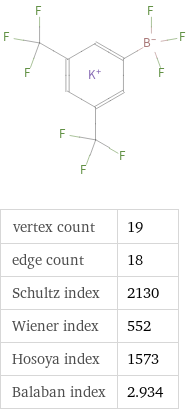
vertex count | 19 edge count | 18 Schultz index | 2130 Wiener index | 552 Hosoya index | 1573 Balaban index | 2.934
Quantitative molecular descriptors
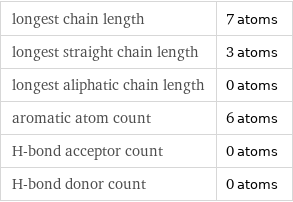
longest chain length | 7 atoms longest straight chain length | 3 atoms longest aliphatic chain length | 0 atoms aromatic atom count | 6 atoms H-bond acceptor count | 0 atoms H-bond donor count | 0 atoms
Elemental composition

Find the elemental composition for potassium 3, 5-bis(trifluoromethyl)phenyltrifluoroborate in terms of the atom and mass percents: atom percent = N_i/N_atoms × 100% mass percent = (N_im_i)/m × 100% Plan: • Write the chemical formula and gather atomic masses from the periodic table. • Determine values for N_i, m_i, N_atoms and m using these items. • Finally, compute the percents and check the results. Write the chemical formula: C_8H_3BF_9K Use the chemical formula, C_8H_3BF_9K, to count the number of atoms, N_i, for each element and find the total number of atoms, N_atoms: | number of atoms F (fluorine) | 9 C (carbon) | 8 B (boron) | 1 K (potassium) | 1 H (hydrogen) | 3 N_atoms = 9 + 8 + 1 + 1 + 3 = 22 Divide each N_i by N_atoms to calculate atom fractions. Then use the property that atom fractions must sum to one to check the work: | number of atoms | atom fraction F (fluorine) | 9 | 9/22 C (carbon) | 8 | 8/22 B (boron) | 1 | 1/22 K (potassium) | 1 | 1/22 H (hydrogen) | 3 | 3/22 Check: 9/22 + 8/22 + 1/22 + 1/22 + 3/22 = 1 Compute atom percents using the atom fractions: | number of atoms | atom percent F (fluorine) | 9 | 9/22 × 100% = 40.9% C (carbon) | 8 | 8/22 × 100% = 36.4% B (boron) | 1 | 1/22 × 100% = 4.55% K (potassium) | 1 | 1/22 × 100% = 4.55% H (hydrogen) | 3 | 3/22 × 100% = 13.6% Look up the atomic mass, m_i, in unified atomic mass units, u, for each element in the periodic table: | number of atoms | atom percent | atomic mass/u F (fluorine) | 9 | 40.9% | 18.998403163 C (carbon) | 8 | 36.4% | 12.011 B (boron) | 1 | 4.55% | 10.81 K (potassium) | 1 | 4.55% | 39.0983 H (hydrogen) | 3 | 13.6% | 1.008 Multiply N_i by m_i to compute the mass for each element. Then sum those values to compute the molecular mass, m: | number of atoms | atom percent | atomic mass/u | mass/u F (fluorine) | 9 | 40.9% | 18.998403163 | 9 × 18.998403163 = 170.985628467 C (carbon) | 8 | 36.4% | 12.011 | 8 × 12.011 = 96.088 B (boron) | 1 | 4.55% | 10.81 | 1 × 10.81 = 10.81 K (potassium) | 1 | 4.55% | 39.0983 | 1 × 39.0983 = 39.0983 H (hydrogen) | 3 | 13.6% | 1.008 | 3 × 1.008 = 3.024 m = 170.985628467 u + 96.088 u + 10.81 u + 39.0983 u + 3.024 u = 320.005928467 u Divide the mass for each element by m to calculate mass fractions. Then use the property that mass fractions must sum to one to check the work: | number of atoms | atom percent | mass fraction F (fluorine) | 9 | 40.9% | 170.985628467/320.005928467 C (carbon) | 8 | 36.4% | 96.088/320.005928467 B (boron) | 1 | 4.55% | 10.81/320.005928467 K (potassium) | 1 | 4.55% | 39.0983/320.005928467 H (hydrogen) | 3 | 13.6% | 3.024/320.005928467 Check: 170.985628467/320.005928467 + 96.088/320.005928467 + 10.81/320.005928467 + 39.0983/320.005928467 + 3.024/320.005928467 = 1 Compute mass percents using the mass fractions: Answer: | | | number of atoms | atom percent | mass percent F (fluorine) | 9 | 40.9% | 170.985628467/320.005928467 × 100% = 53.43% C (carbon) | 8 | 36.4% | 96.088/320.005928467 × 100% = 30.03% B (boron) | 1 | 4.55% | 10.81/320.005928467 × 100% = 3.378% K (potassium) | 1 | 4.55% | 39.0983/320.005928467 × 100% = 12.22% H (hydrogen) | 3 | 13.6% | 3.024/320.005928467 × 100% = 0.9450%
Elemental oxidation states

The first step in finding the oxidation states (or oxidation numbers) in potassium 3, 5-bis(trifluoromethyl)phenyltrifluoroborate is to draw the structure diagram. Next set every oxidation number equal to the atom's formal charge: In potassium 3, 5-bis(trifluoromethyl)phenyltrifluoroborate hydrogen is not bonded to a metal with lower electronegativity, so it will have an oxidation state of +1. Any element bonded to hydrogen gains the bonding electrons, decreasing their oxidation state by 1 for every bond: With hydrogen out of the way, look at the remaining bonds. There are 1 boron-carbon bond, 3 boron-fluorine bonds, 6 carbon-fluorine bonds, and 8 carbon-carbon bonds. For each of these bonds, assign the bonding electrons to the most electronegative element. First examine the boron-carbon bond: element | electronegativity (Pauling scale) | B | 2.04 | C | 2.55 | | | Since carbon is more electronegative than boron, the electrons in this bond will go to carbon. Decrease the oxidation number for carbon (by 1 for single bonds, 2 for double bonds, and 3 for triple bonds), and increase the oxidation number for boron accordingly: Next look at the boron-fluorine bonds: element | electronegativity (Pauling scale) | B | 2.04 | F | 3.98 | | | Since fluorine is more electronegative than boron, the electrons in these bonds will go to fluorine: Next look at the carbon-fluorine bonds: element | electronegativity (Pauling scale) | C | 2.55 | F | 3.98 | | | Since fluorine is more electronegative than carbon, the electrons in these bonds will go to fluorine: Next look at the carbon-carbon bonds: element | electronegativity (Pauling scale) | C | 2.55 | C | 2.55 | | | Since these elements are the same the bonding electrons are shared equally, and there is no change to the oxidation states: Now summarize the results: Answer: | | oxidation state | element | count -1 | C (carbon) | 4 | F (fluorine) | 9 0 | C (carbon) | 2 +1 | H (hydrogen) | 3 | K (potassium) | 1 +3 | B (boron) | 1 | C (carbon) | 2
Orbital hybridization
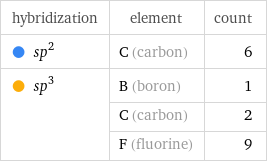
hybridization | element | count sp^2 | C (carbon) | 6 sp^3 | B (boron) | 1 | C (carbon) | 2 | F (fluorine) | 9
Structure diagram
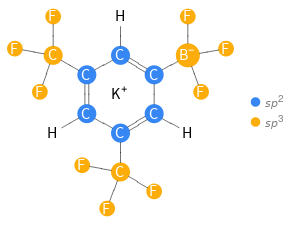
Orbital hybridization Structure diagram
Topological indices
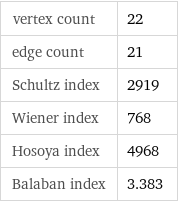
vertex count | 22 edge count | 21 Schultz index | 2919 Wiener index | 768 Hosoya index | 4968 Balaban index | 3.383